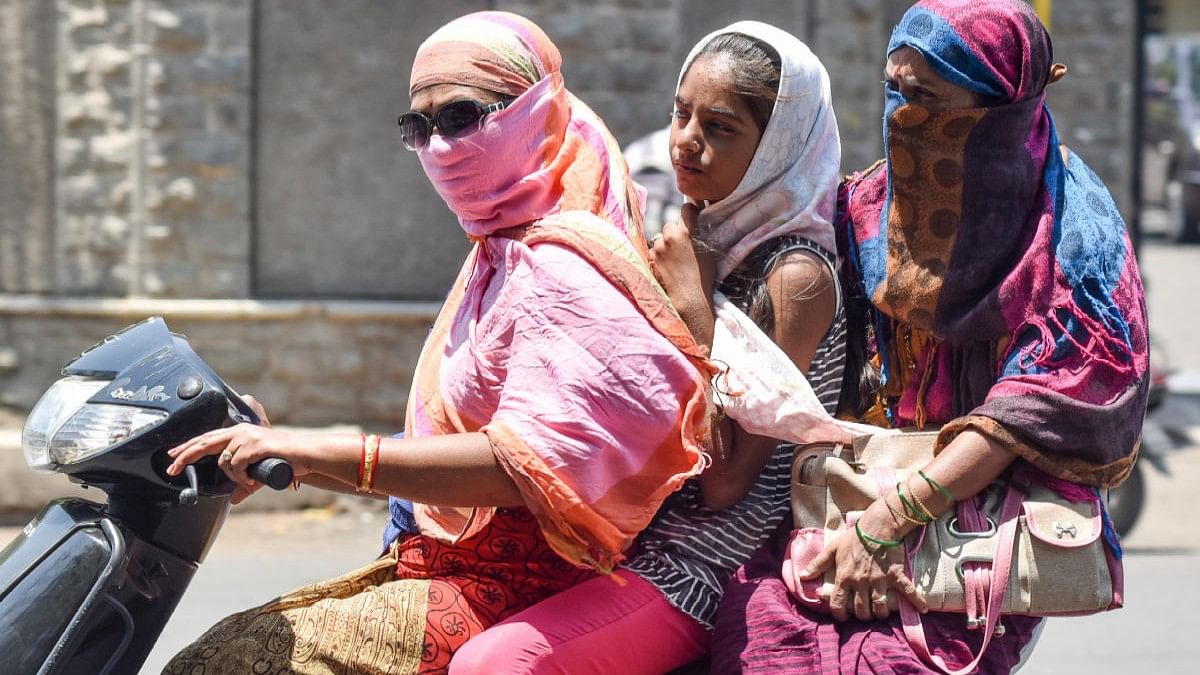
Extreme heat conditions during summer. For representation.
DH file photo
New projections of climate change impacts released on Sunday by researchers from the Azim Premji University paint an alarming picture of extreme weather events in India, with the data showing about one degree Celsius increase in summer maximum temperature in nearly 200 districts. The data also shows that an equal number of districts will see about 20% increase in rainfall combined with increase in days of heavy rainfall events, including Udupi, Yadgir and Kalaburagi of Karnataka, within the next 10 years compared to 1960s in the current emission scenario.
Led by Prof Harini Nagendra of the varsity, researchers assessed the climate change impact on India from two of the five scenarios laid out by the Intergovernmental Panel on Climate Change (IPCC) of the United Nations. First, the moderate scenario known as “SSP 2-4.5” where CO2 emissions stay around current levels and reach net zero emissions by 2100. Secondly, a high emission scenario (“SSP 5-8.5”) where CO2 emissions double by 2050.
The data for change in summer maximum temperature showed that 228 districts or roughly one third of the country, will see 0.91 to 1.62 degrees C rise. Another 251 districts will see 0.5-0.9 degree C rise.
The top 10 worst affected districts were in the Himalayan states of Ladakh, Jammu and Kashmir and Himachal Pradesh.
In Rajasthan 120 of the 123 districts will see 1.01-1.33 degree C rise while 33 districts of Madhya Pradesh will see 0.91 to 1.28 degree C rise.
Rainfall to increase
For a country dependent on monsoon, the projection that 205 districts will see 19.58% to 37.46% increase in the southwest monsoon should come as good news. However, the change in the patterns of rainfall, like heavy rain in a short duration and the lack of infrastructure to deal with such events is a major cause for worry.
All the 33 districts in Gujarat, 50 of the 75 districts in UP, all the 11 in Delhi, 21 of 36 in Maharashtra, 20 of 33 in Rajasthan, 10 of 30 in Karnataka, nine of 22 in Punjab and five of 37 in Tamil Nadu are among the districts that will see over 20% increase in rainfall.
However, the change in the patterns of rainfall, like heavy rain in a short duration and the lack of infrastructure to deal with such events is a major cause for worry.
All the 33 districts in Gujarat, 50 of the 75 districts in Uttar Pradesh, all the 11 in Delhi, 21 of 36 in Maharashtra, 20 of 33 in Rajasthan, 10 of 30 in Karnataka, nine of 22 in Punjab and five of 37 in Tamil Nadu are among the districts that will see over 20% increase in rainfall.
Flood warning
The analysis showed that the number of days with heavy rainfall during the southwest monsoon will increase by one day to 5.62 days in 590 districts. Such a change in a district, whether or not an increase in the amount of rainfall, will come with its own problems.
“What we are seeing here is changes of multiple parameters which will have a direct impact on the livelihood of people, especially the vulnerable sections of the society,” said Harini Nagendra, whose team of researchers spent over three years on the study.
She said the increase in temperature, heatwave and humidity on the one hand and the increase in the percentage of rain and rise in the number of days of heavy rain all need to be considered to make decisions. “We not only need climate resilient infrastructure but policy instruments that are aimed at prevention of damage and mitigation of the suffering,” she said.
Prof Santonu Goswami, who worked on the study, said best results from 13 top-performing CMP6 global climate models to develop an ensemble average to reduce uncertainty in their assessment. “Our findings for all the states and districts are now open to the public as well as policymakers. This is part of our effort to democratise the data so that anyone interested in understanding the changes should get the information,” he said.